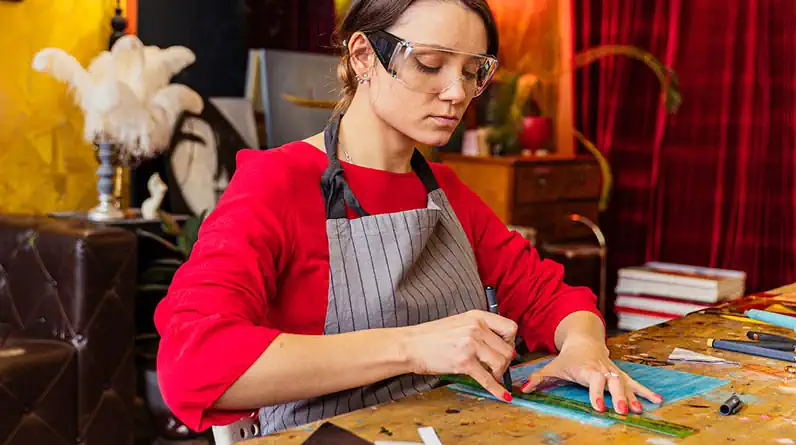
Lead Came Technique for Stained Glass
The material used to keep individual pieces of glass together is called “lead came”. It is an H-shaped channel that the glass pieces are inserted into and then soldered together.
Lead is malleable and can be bent to fit the shape of the glass. The highest quality lead used for making windows is 99% pure, and with time, the outer layer will oxidize and assume a white hue, but that does not compromise the metal’s durability which can last up to 150 years or longer.
There are also lead cames made with other metals such as tin, which are stiffer but more prone to rusting when exposed to moisture, resulting in the disintegration of the came. Lead came comes in different widths and thicknesses, with the medium-thickness option being 3/8″ or 1/4″, and the heart of the lead measuring 3/32″ to 1/16″.
Choosing the right stained glass lead came technique is an important decision, as it affects the look and quality of the finished product. A good lead came technique can make the difference between a beautiful piece of stained glass, and an ugly one. Learn about the different techniques that are available and how to choose the best one for you.
Re-leading
Using lead cames is a cheap way to lower the cost of stained glass artwork. However, it is important to keep in mind that lead cames can break. The main reason is exposure to the elements.
In addition, a poor lead came can sag or bow and result in bowed or sagging stained glass. Re-leading can preserve artwork in stained glass windows while transferring the load back to a new lead framework.
The best way to know if your lead came is in need of re-leading is to look at the original glass. If it is a bowed and sagging panel, then you will need to decide if it is worth saving or if it’s time for a replacement.
The new lead cames have 250% more tensile strength than their predecessors. However, there are other factors to consider. For example, if the panel is made of a metal framework, then the came may need reinforcing. It also depends on the historic context of the leaded lights.
Some artisans cover gaps with solder. However, a more effective method is to make it airtight by applying putty. Putting putty on the artwork helps to keep it weatherproof.
However, putty is susceptible to changes in atmospheric conditions. For example, if a window is exposed to unusually high wind gusts, the putty will crumble. This is a good reason to check the condition of your leaded light windows regularly.
One other reason to check your lead came is the presence of micro cracks. Although micro cracks may be invisible to the naked eye, they are visible to the microscope.
The lead cames of medieval times were stronger and better suited to handling wind forces than their predecessors. During World Wars, lead alloys were refined to remove extraneous metals and make the metal more pure. These processes also produced lead that is thinner. However, lead is still a soft metal and deforms easily. It is also susceptible to serious oxidation, which leads to degradation and failure.
Gemmail
Using lead came to create a stained glass window frame is one thing, using it to create a gemmail panel is another. For the uninitiated, this is a technique that was first devised by a French painter in the 1930s.
A modern gemmail panel is created by overlapping colored glass pieces. These pieces are then glued together with a clear substance. These panels are subsequently heated and reassembled into an aesthetically pleasing and functional work of art.
A lead came is a sturdy, weatherproof material that has the best of both worlds. The most effective uses of the medium are for window and wall panels, or in the case of the latter, for a chandelier. To make the most of this material, it is best to purchase a roll of the stuff. This is a good way to avoid splinters and accidental breakage.
To do this, you will need a few items: a lead came, a glass block, a wood block, a horseshoe nail, a lead knife, a hammer, and a small glass plate. This is a relatively cheap process, and can be completed in a matter of minutes. If you are lucky, you might even come across an artist who is willing to give you a hand.
The most exciting part of the process is putting together the finished product. This is where the aforementioned artist might be able to put your talents to the test. If this is the case, you could end up with a gemmail panel that is as good as, or even better than, the original.
The best part of all is knowing that you are now part of a thriving community of artists and aficionados. You will also be able to participate in a number of activities and events that will enrich your glass experience.
What is Dalle de Verre?
The most popular new technique for stained glass windows is Dalle de Verre. This technique consists of thicker glass that produces rich colors. The technique also requires the use of special epoxy and is ideal for use in window openings. It is also compatible with figure work and lettering.
Traditionally, lead was used to join glass pieces. Today, new types of lead strips are available for stained glass windows. These strips come in a variety of widths, and are used to provide strength and durability to stained glass windows.
- The Dalle de Verre technique has been revived by French glass artists. Some of these techniques were practiced in the Middle East for hundreds of years, but they have been lost to time. In the 1920s, glass artists from France revived these techniques. These artists also combined glass with various materials.
- The Dalle de Verre technique can be framed in a wall opening or used for a stained glass window. These windows are often set on T-bars. They are also subject to wind, hail, and rain. The glass is generally smooth, but can also be textured.
- The Dalle de Verre technique lends itself to a direct approach to design. It doesn’t encourage copious detail. It is best displayed in strong sunlight, which gives facets in the glass sparkle.
- The Dalle de Verre technique is compatible with figure work, delicate detail, and lettering. It can also be used to create entire walls.
- The Dalle de Verre technique produces a mosaic-like approach to the pure color effects of the glass. The depth of color gives this technique a rich translucence.
Conclusion
Choosing the right stained glass lead came technique is an important decision, as it affects the look and quality of the finished product. A good lead came technique can make the difference between a beautiful piece of stained glass, and an ugly one.
While lead came is a durable, malleable metal that works well for a variety of applications, it does have its drawbacks. The most important factor to consider when making this important decision is the amount of customization that you need to do with your stained glass windows.







